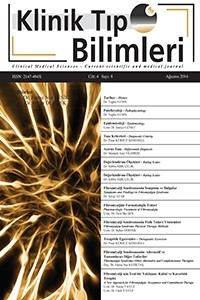“Hipertansiyon ve Egzersiz; İyi Ama Nasıl”
Öz
Hipertansif hastalarda egzersizin kan basıncını düşürücü etkisinden yaralanılmalıdır. Egzersiz ile elde edilecek etkinin sağlanması için egzersizin sıklığı, yoğunluğu, tipi ve süresinin belirlenmesi gerekir. Bu paramatreler maksimal faydanın elde edilmesi açısından önemlidir. Ancak koroner kalp hastalığı gibi komorbiditesi bulunan hastalardayoğunluk sınırlarının hastaya göre belirlenmesi istenmeyen olaylardan kaçınmak açısından gereklidir.
Anahtar Kelimeler:
Hipertansiyon, egzersiz, kardiyovasküler koruma
"Hypertension and Exercise; Good But how"
AbstractExercise has beneficial effect on high blood pressure and should be used this effect. For obtained this effect there is need to be determine its ferquency, intensity, typeand time. These parameters important for maximal profit to be obtained. But intensityof its need to be individualized for avoiding advers events in patients have comorbid condition such as coronary heart dissease,
Keywords:
Hypertension, exercise, cardiovascular prevention,
___
- Kaynaklar 1.Brown RE, Riddell MC, Macpherson AK, Canning KL, Kuk JL. Thejoint association of physical activity, blood-pressure control and phar-macologic treatment of hypertension for all-cause mortality risk. AmJ Hypertens. 2013;26:1005–10. 2.Pescatello LS, Franklin BA, Fagard R, FarquharWB, Kelley GA, RayCA, et al.American college of sportsmedicine position stand: exer-cise and hypertension. Med Sci Sports Exerc. 2004;36:533–53. 3.Cornelissen VA, Fagard RH, Coeckelberghs E, Vanhees L. Impactof resistance training on blood pressure and other cardiovascularrisk factors: a meta-analysis of randomized, controlled trials.Hypertension. 2011;58:950–8. 4.Fitzgerald W. Labile hypertension and jogging: New diagnostic toolor spurious discovery? Br Med J (Clin Res Ed). 1981;282: 542–4. 5.Chobanian AV, Bakris GL, Black HR, Cushman WC, Green LA, IzzoJr JL, et al. Seventh report of the joint national committee on pre-vention, detection, evaluation, and treatment of high blood pressu-re. Hypertension. 2003;42:1206–52. 6.James PA, Oparil S, Carter BL, Cushman WC, Dennison- Himmel-farb C, Handler J, et al. Evidence-based guideline for the manage-ment of high blood pressure in adults: Report from the panel mem-bers appointed to the eighth Joint National Committee (JNC 8). JAMA.2014;311:507–20. 7.Eckel RH, Jakicic JM, Ard JD, de Jesus JM, Houston Miller N, Hub-bard VS, et al. 2013 AHA/ACC guideline on lifestyle managementto reduce cardiovascular risk: a report of the American College ofCardiology/American Heart Association task force on practice gui-delines. J Am Coll Cardiol. 2014;63:2960–84. 8.Brook RD, Appel LJ, Rubenfire M, Ogedegbe G, Bisognano JD, El-liott WJ, et al. Beyond medications and diet: alternative approachesto lowering blood pressure: a scientific statement from the Ameri-can heart association. Hypertension. 2013;61:1360–83. 9.Mancia G, Fagard R, Narkiewicz K, Redon J, Zanchetti A, Bohm ,M,et al. 2013 ESH/ESC practice guidelines for the management of ar-terial hypertension. Blood Press. 2014;23:3–16. 10.Dasgupta K, Quinn RR, Zarnke KB, Rabi DM, Ravani P, Daskalo-poulou SS, et al. The 2014 Canadian hypertension education prog-ram recommendations for blood pressure measurement, diagnosis,assessment of risk, prevention, and treatment of hypertension. CanJ Cardiol. 2014;30:485–501. 11.Eicher JD, Maresh CM, Tsongalis GJ, Thompson PD, Pescatello LS.The additive blood pressure lowering effects of exercise intensity onpost-exercise hypotension. Am Heart J. 2010;160:513– 20. 12.Molmen-Hansen HE, Stolen T, Tjonna AE,Aamot IL, Ekeberg IS,TyldumGA, et al. Aerobic interval training reduces blood pressureand improves myocardial function in hypertensive patients. Eur J PrevCardiol. 2012;19:151–60. 13.Bhammar DM, Angadi SS, Gaesser GA. Effects of fractionized andcontinuous exercise on 24-h ambulatory blood pressure. Med SciSports Exerc. 2012;44:2270–6. 14.Mota MR, Oliveira RJ, Terra DF, Pardono E, Dutra MT, de Almei-da JA, et al. Acute and chronic effects of resistance exercise on blo-od pressure in elderly women and the possible influence of ACE I/Dpolymorphism. Int J Gen Med. 2013;6:581–7. 15.Hayashino Y, Jackson JL, Fukumori N, Nakamura F, Fukuhara S.Effects of supervised exercise on lipid profiles and blood pressurecontrol in people with type 2 diabetes mellitus: a meta-analysis ofrandomized controlled trials. Diabetes Res Clin Pract. 2012;98:349–60. 16.Pescatello, L. S., G. W. Mack, C. N. Leach, Jr., and E. R. Nadel. Ther-moregulation in mildly hypertensive men during beta-adrenergic bloc-kade. Med. Sci. Sports Exerc. 22: 222–228, 1990. 17.Gordon, N. F. Hypertension. In: ACSM's Exercise Management forPersons with Chronic Diseases and Disabilities, J. L. Durstine (Ed.).Champaign, IL: Human Kinetics, 1997, pp. 59–63. 18.Franklin, B. A., M. H. Whaley, and E. T. Howley (Eds.). ACSM's Gui-delines for Exercise Testing and Prescription, 6th Ed. Baltimore: Lip-pincott Williams & Wilkins, 2000. 19.Jakicic, J. M., K. Clark, E. Coleman, et al. American College of SportsMedicine position stand: appropriate intervention strategies for we-ight loss and prevention of weight regain for adults. Med. Sci. SportsExerc. 33: 2145–2156, 2001 20.National Institutes of Health and National Heart, Lung, and BloodInstitute. Clinical guidelines on the identification, evaluation, andtreatment of overweight and obesity in adults: the Evidence Report.Obes. Res. 6( Suppl. 2): 51S-209S, 1998. 21.U.S. Department of Health and Human Services. Physical activityand health: a report of the Surgeon General. Atlanta, GA: U.S. De-partment of Health and Human Services, Centers for Disease Con-trol and Prevention, and National Center for Chronic Disease Pre-vention and Health Promotion, 1996. 22.Seals, D. R., J. M. Hagberg, B. F. Hurley, A. A. Ehsani, and J. O.Holloszy. Endurance training in older men and women. I. Cardio-vascular responses to exercise. J. Appl. Physiol. 57: 1024–1029, 1984 23.Kohrt, W. M., M. T. Malley, A. R. Coggan, et al. Effects of gender,age, and fitness level on response of VO2max to training in 60–71yr olds. J. Appl. Physiol. 71: 2004–2011, 1991 24.Pescatello, L. S., L. Bairos, J. L. Vanheest, et al. Postexercise hypo-tension differs between white and black women. Am. Heart J. 145:364–370, 2003. 25.Williams, M. A., J. L. Fleg, P. A. Ades, et al. Secondary preventionof coronary heart disease in the elderly (with emphasis on patients≥ 75 years of age). An American Heart Association Scientific Statement from the Council on Clinical Cardiology Subcommittee onExercise, Cardiac Rehabilitation, and Prevention. Circulation 105:1735–1743, 2002
- ISSN: 2147-494X
- Başlangıç: 2013
- Yayıncı: Selen Medya Yayıncılık Tanıtım ve Organizasyon Hizmetleri
Sayıdaki Diğer Makaleler
Çocuk ve Ergenlerde Hipertansiyon:Son Gelişmeler Işığında Tanı ve Tedavi?
Obezite Epidemiyolojisi ve Korunma
Sağlıklı Beslenme –Neleri Gözden Kaçırıyoruz?
“Hipertansiyon ve Egzersiz; İyi Ama Nasıl”
Kimde Sekonder Hipertansiyon Aramalıyım?
Obezitede Diyetin Düzenlenmesi
Hipertansiyonda Akılcı İlaç Tedavisi
Antihipertansif Tedavide Kalp Hızı:Dikkate Alınmalı Mı?
Tedavi Hedefleri: Ne Kadar Kabul Edilebilir?
